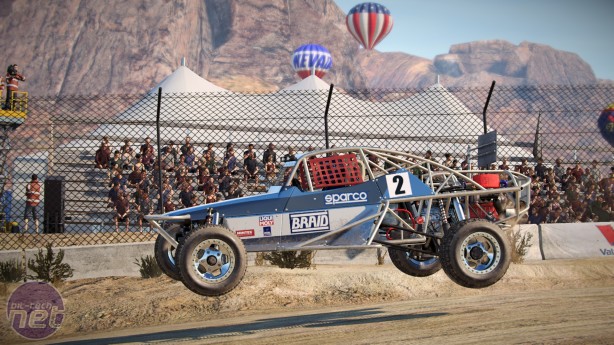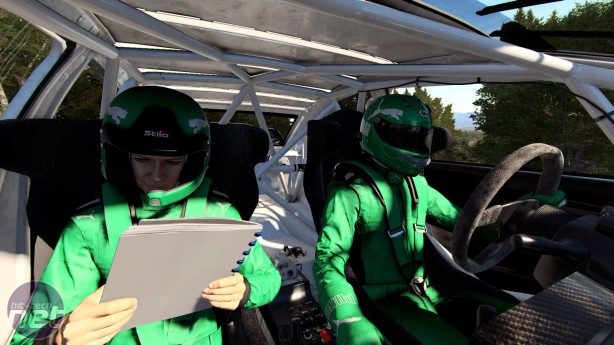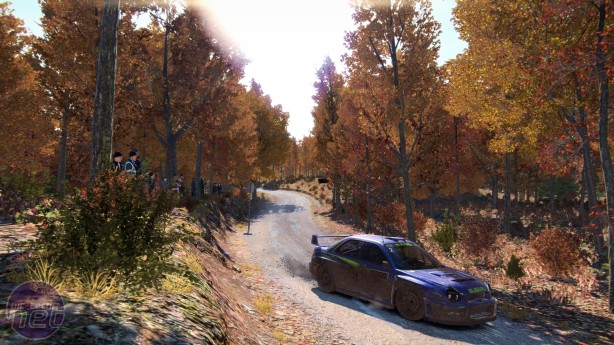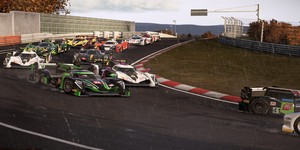
In these moments, Dirt 4 is at its most thrilling and terrifying, as you are forced to race almost blind, relying almost entirely on the calls of your co-driver. Speaking of which, co-drivers are considerably chattier, updating you with stage-specific information and the current status of your car at the start line. You can also choose between several co-drivers, including a handful of rallying veterans such as Nicky Grist and Jen Horsey.
One of the most interesting tweaks to the formula is that you no longer stop driving once you’ve crossed the finish line. Instead, you must now drive your car up to a marshal at the end of the stage. It may sound like an odd addition, but it has a dramatic effect on the game. Any damage you take during the race will carry over to the next stage until you can make repairs at a service area. That includes damage taken after you’ve crossed the finish line. This means you must race with care and precision right up to the death and can no longer bomb it across the finish line just to shave a few tenths of a second off your time.
Such small but effective adjustments are a running theme throughout Dirt 4, and they apply to the cars themselves too. Both handling and damage are modelled with remarkable accuracy. The difference in weight, turn-speed, and acceleration between car-types and individual models is palpable. You can tell instantly if you’ve suffered a flat tyre or a damaged gearbox just by the change in how the car moves and sounds. Few racers I’ve played communicate a car’s performance and how that changes through as race as effectively as Dirt 4 does.
Although rallying is undoubtedly Dirt 4’s main event, the other available modes are just as fun to play. 'Rallycross' lets you compete with other cars on set tracks and introduces the 'Joker' lap rule, where once per race you must drive through a different, longer section of track to the other racers, adding an element of tactics to the proceedings. 'Land Rush', meanwhile, sees you racing dune buggies and hulking trucks across sand-tracks with wide, drifting turns and dramatic jumps. While all the modes are enjoyable, Land Rush is probably the least stressful of the three, allowing you a little more room to be cavalier with speed and drifting.
Should you exhaust the generous career mode, Dirt 4 lets you generate your own rally tracks through 'Your Stage', thus offering potentially infinite replayability. It’s worth noting that, in general, Dirt 4 does a fantastic job of evoking the improvisational nature of rallying, from those unpredictable hazards like crashes or fog to mechanical problems which occur mid-race. Your Stage is the culmination of this, as once you’ve explored all the set tracks, you aren’t limited to replaying them until all the surprise evaporates.
It's just as well Dirt 4 comes with this procedural track generator, because otherwise one could easily accuse the game’s track roster of being a little thin. Dirt 4 has only five rallying environments compared to Dirt Rally’s six, and two of these, Wales and Sweden, already featured in Dirt Rally. Rallycross and Land Rush also feel underserved compared to vanilla rallying, with only a handful of tracks for each. Taken all together there’s still plenty to get your teeth into, but given just how much Dirt 4 borrows from Dirt Rally, I don’t think it’s unfair to expect a little more.
Still, there’s no question that Dirt 4 represents a triumph for Codemasters, a smart and comprehensive off-road racer that offers a gentler learning curve for newcomers, while also building on the groundwork done by Dirt Rally to make its racing even more forbidding on the hardest difficulties. It’s success does rely heavily on the work already done in the previous game, but as a broader and less punishing alternative to Dirt Rally, it does its job superbly.
One of the most interesting tweaks to the formula is that you no longer stop driving once you’ve crossed the finish line. Instead, you must now drive your car up to a marshal at the end of the stage. It may sound like an odd addition, but it has a dramatic effect on the game. Any damage you take during the race will carry over to the next stage until you can make repairs at a service area. That includes damage taken after you’ve crossed the finish line. This means you must race with care and precision right up to the death and can no longer bomb it across the finish line just to shave a few tenths of a second off your time.
Such small but effective adjustments are a running theme throughout Dirt 4, and they apply to the cars themselves too. Both handling and damage are modelled with remarkable accuracy. The difference in weight, turn-speed, and acceleration between car-types and individual models is palpable. You can tell instantly if you’ve suffered a flat tyre or a damaged gearbox just by the change in how the car moves and sounds. Few racers I’ve played communicate a car’s performance and how that changes through as race as effectively as Dirt 4 does.
Although rallying is undoubtedly Dirt 4’s main event, the other available modes are just as fun to play. 'Rallycross' lets you compete with other cars on set tracks and introduces the 'Joker' lap rule, where once per race you must drive through a different, longer section of track to the other racers, adding an element of tactics to the proceedings. 'Land Rush', meanwhile, sees you racing dune buggies and hulking trucks across sand-tracks with wide, drifting turns and dramatic jumps. While all the modes are enjoyable, Land Rush is probably the least stressful of the three, allowing you a little more room to be cavalier with speed and drifting.
Should you exhaust the generous career mode, Dirt 4 lets you generate your own rally tracks through 'Your Stage', thus offering potentially infinite replayability. It’s worth noting that, in general, Dirt 4 does a fantastic job of evoking the improvisational nature of rallying, from those unpredictable hazards like crashes or fog to mechanical problems which occur mid-race. Your Stage is the culmination of this, as once you’ve explored all the set tracks, you aren’t limited to replaying them until all the surprise evaporates.
It's just as well Dirt 4 comes with this procedural track generator, because otherwise one could easily accuse the game’s track roster of being a little thin. Dirt 4 has only five rallying environments compared to Dirt Rally’s six, and two of these, Wales and Sweden, already featured in Dirt Rally. Rallycross and Land Rush also feel underserved compared to vanilla rallying, with only a handful of tracks for each. Taken all together there’s still plenty to get your teeth into, but given just how much Dirt 4 borrows from Dirt Rally, I don’t think it’s unfair to expect a little more.
Still, there’s no question that Dirt 4 represents a triumph for Codemasters, a smart and comprehensive off-road racer that offers a gentler learning curve for newcomers, while also building on the groundwork done by Dirt Rally to make its racing even more forbidding on the hardest difficulties. It’s success does rely heavily on the work already done in the previous game, but as a broader and less punishing alternative to Dirt Rally, it does its job superbly.


MSI MPG Velox 100R Chassis Review
October 14 2021 | 15:04













Want to comment? Please log in.